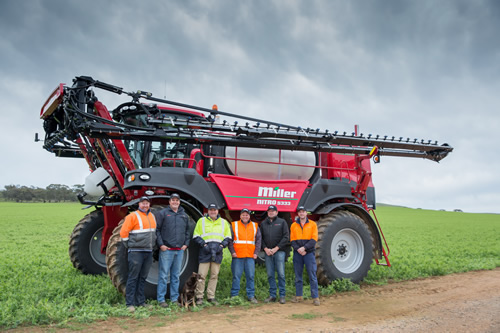

03 November 2015

Pictured with one of the Miller Nitro 5000 series multi-task sprayers on Princess Royal Station, near Burra in South Australia, is Daniel Booth, Princess Royal Station, Nigel Hodge, McIntosh Distribution, Simon Rowe, Princess Royal Station and John Martin and David Hall, both of Ramsey Brothers Riverton.
PRINCESS Royal Station is one of the country’s iconic pastoral properties, but it’s also home to a thriving agricultural enterprise.
Shawn Rayson is the cropping manager at Princess Royal Station, located near Burra in South Australia, and is responsible for the station’s 8200-hectare cropping program.
With such an extensive program, Shawn said they were always looking at ways to be more efficient and increase productivity.
One way they have successfully been able to do this is by upgrading machinery, specifically introducing Miller Nitro 5000 series multi-task sprayers.
Shawn said they were operating two of the Nitro 5000 series self-propelled sprayers, each with a 6100-litre tank, purchased through Ramsey Bros, Riverton, via McIntosh Distribution.
“The main drawcard to us was the versatility,” Shawn said.
“It allows us to maximise the use from one piece of machinery, rather than having something that sits in the shed for 11 months of the year until we need it.”
With a variant of 300-460 millimetres of annual rainfall, Princess Royal’s 8200ha cropping program includes 3000ha of wheat, 3000ha of barley, 400ha of peas, 260ha of canola and the remainder of oats.
From this, they cut 10,000 tonne of silage and 10,000 bales of hay.
Considering the Nitro is capable of spraying, spot spraying with WeedSeeker booms, swathing, fertiliser injection and fertiliser spreading, all switched easily via a Quick-Attach system, Shawn said they were never sitting idle for long.
“In January, we use them for summer spraying and through seeding they will be used for spraying until the end of August, beginning of September,” he said.
“Then the hay front and canola fronts will be put on until all the hay and silage are cut and the canola is swathed.
“Then it will be used for spraying again, as we spray the windrowed canola for ryegrass and any other weeds – we’re able to spray at 60L/ha and cut 100ha between fills.
“Once you’ve changed the front a few times, it only takes 10-15 minutes to do.
“It’s very straightforward and simple, but we’ve also had great support from McIntosh (Distribution) and Ramsey Bros.”
Previously, Shawn said they used a 24-metre (80-foot) Hardi Commander tow-behind boom with 5000L tank and a Hardi Saritor 30m (100ft) self-propelled boom with a 4800L tank.
He said the Nitros were able to do so much more, while even on the basic spraying front they were a lot more efficient.
“There is a big range of country out here. We’ve got hills, creeks, trees – we need something that can handle everything.”
“With the Nitro, we can spray at 120ft through to 70ft regardless of the country and with ease. It just allows us to be so much more versatile with where we can go, as well as what we can do.”
The design of the Nitro boom creates significantly less wind disturbance and Shawn said this equated to minimal dust during summer spraying, which was a big advantage.
He said the cab itself was very comfortable and spacious, but the increase in visibility was an even bigger plus.
“It’s very easy to drive, which when you have six different employees using it as we do, is an important feature.’’
“The front-mounted boom is so much better for visibility. When you’ve got a 120ft boom it makes a big difference when you can see the whole thing and be more aware of your clearance,’’ Shawn said.